Apple iPhone 4S: Thoroughly Reviewed
by Anand Lal Shimpi & Brian Klug on October 31, 2011 7:45 PM EST- Posted in
- Smartphones
- Apple
- Mobile
- iPhone
- iPhone 4S
Faster Throughput on WCDMA
Fixing unintended attenuation is only one part of what’s new however, the other part of the story is faster cellular connectivity for users on WCDMA/UMTS carriers. Users who are using the 4S on CDMA (like Sprint or Verizon) won’t see a performance difference since this is still the same EVDO Rev.A.
The iPhone 4 used an Intel/Infineon X-Gold 618 which supported HSDPA 7.2 and HSUPA 5.76. The MDM6610 inside the 4S supports HSDPA 14.4 and HSUPA 5.76, alongside a number of 3GPP Rel.7 features which are colloquially known as HSPA+. I talked about this extensively in another piece when there was some confusion about whether or not the 4S is HSPA+ - which it is.
| iPhone Cellular Speeds | ||||
| Property | iPhone 3G/3GS | iPhone 4 (GSM/UMTS) | iPhone 4 (CDMA) | iPhone 4S |
| Baseband | Infineon X-Gold 608 | Infineon X-Gold 618 | Qualcomm MDM6600 | Qualcomm MDM6610 |
| HSDPA | Cat.8 - 7.2 Mbps | Cat.8 - 7.2 Mbps | N/A | Cat.10 - 14.4 Mbps |
| HSUPA | None - 384 Kbps WCDMA only | Cat.6 - 5.76 Mbps | N/A | Cat.6 - 5.76 Mbps |
| EVDO | N/A | N/A | 1x/EVDO Rev.A | 1x/EVDO Rev.A |
The previous X-Gold 618 baseband was a nice improvement over the iPhone 3G/3GS’ X-Gold 608, which lacked HSUPA, but in a world where most WCDMA carriers are at least running HSDPA 14.4, it’s nice to finally have an iPhone with something faster than HSDPA 7.2. I’ve done lots of testing inside my Tucson, AZ market (which is “4G” HSPA+ on AT&T’s coverage viewer) with both the 4 and the 4S, and have built a very good feel for the 4’s performance. As a reminder, if you’re in the USA, those dark blue areas represent HSPA+ coverage areas with AT&T’s upgraded backhaul. In practice these are at least HSDPA 14.4.

Left: iPhone 4 Limited to ~6.1 Mbps down, Right: iPhone 4S (same location) hitting ~9 Mbps
With line of sight to an AT&T NodeB inside my HSPA+ market I’m used to seeing a maximum downstream throughput on the iPhone 4 of almost exactly ~6.1 Mbps, which is about right for the 4’s HSDPA 7.2 maximum when you include overhead. The nice straight line in that result should clue you in that downstream throughput on the 4 was being gated by the baseband. On the 4S, in this same location, I’ve been able to get 9.9 Mbps when the cell isn’t loaded at night (I didn't grab a screenshot of that one, for some reason). It’s nice to finally not be gated by the baseband anymore on an iDevice. Having a faster baseband is part of the reason the 4S’s cellular performance is much better, the other half is receive diversity which helps the 4S push these high throughput rates, and also dramatically improve performance at cell edge.
I did some drive testing with the 4 and 4S side by side and targeted areas that I know have pretty poor signal strength. The 4S is shown in yellow, the 4 in blue.
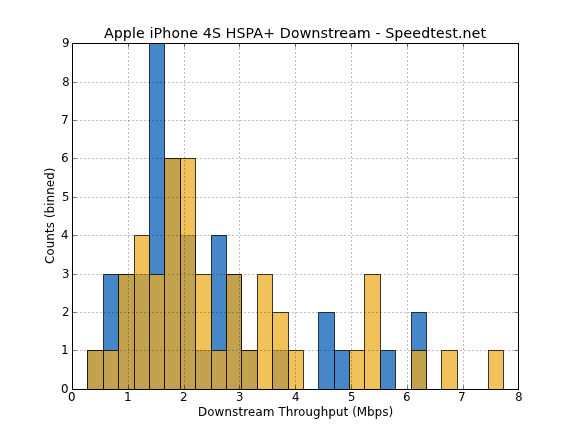
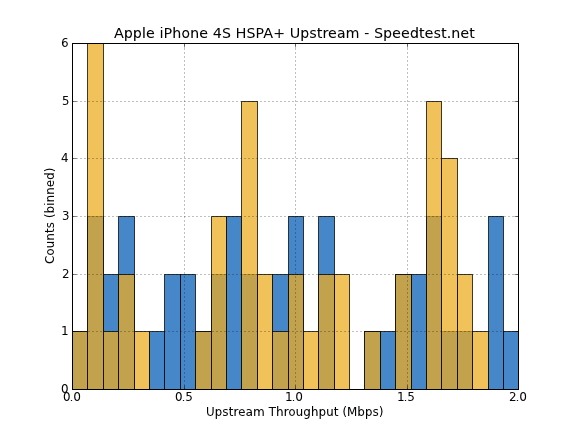
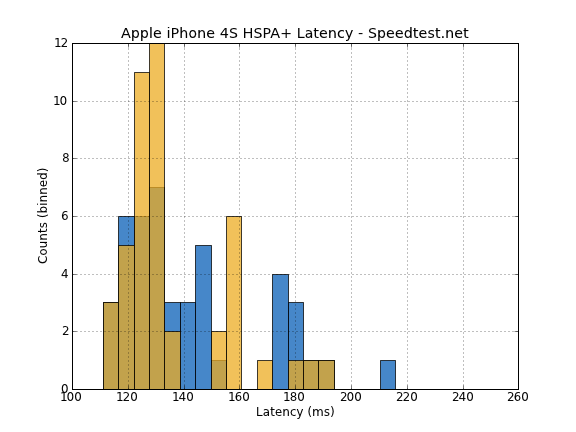
You can see how downstream throughput gets a nice shift up, and the average changes as well, from 2.28 Mbps on the 4 to 2.72 Mbps on the 4S. The maximum in this sample increases from 6.25 to 7.62 Mbps as well. It isn’t a huge shift, but subjectively I’ve noticed the 4S going a lot faster in areas that previously were difficult for the 4.
We’ve also run the usual set of standalone tests on the 4S on AT&T in my market of Tucson, AZ, in Anand’s market of Raleigh, NC, and on Verizon in Raleigh, NC. Though we don’t have a Sprint 4S yet, we hope to do a more serious 4S carrier comparison here in the US when we get one. First up is AT&T which is of course HSPA+ in both of our testing markets.
AT&T HSPA+
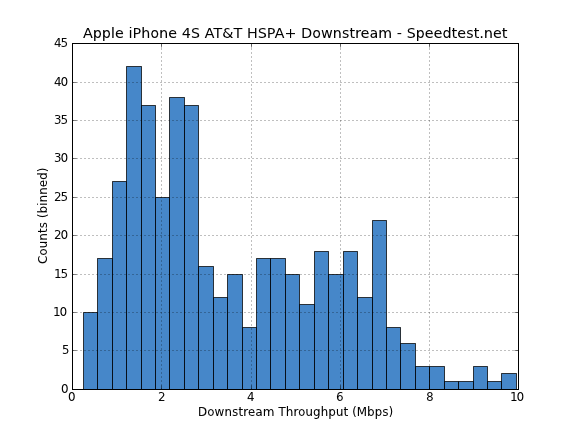
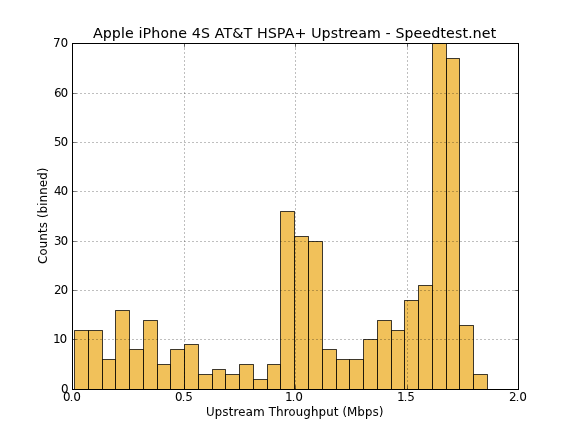

Verizon EVDO
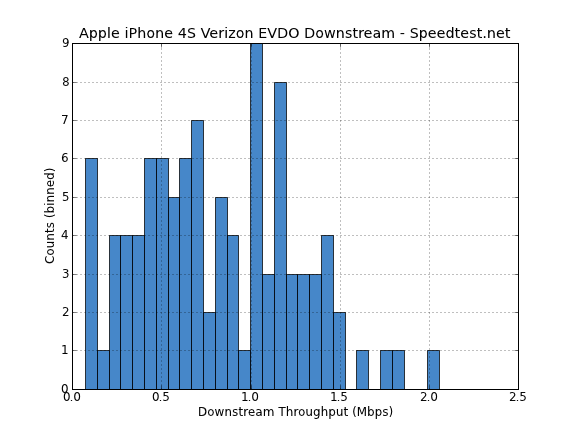
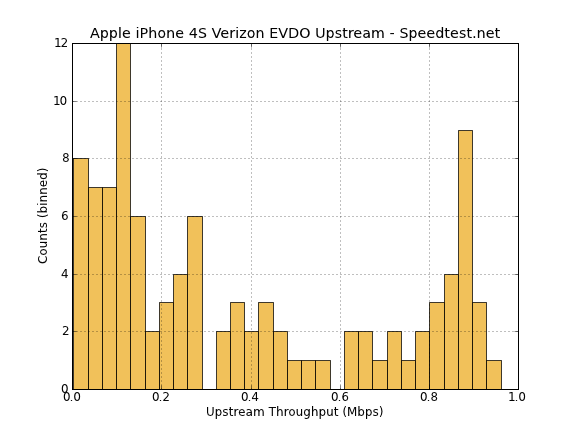

| iPhone 4S Speedtest Comparison | ||||||
| Carrier | AT&T | Verizon | ||||
| Avg | Max | Min | Avg | Max | Min | |
| Downstream (Mbps) | 3.53 | 9.94 | 0.24 | 0.82 | 2.05 | 0.07 |
| Upstream (Mbps) | 1.17 | 1.86 | 0.009 | 0.38 | 0.96 | 0.003 |
| Latency (ms) | 137 | 784 | 95 | 177 | 1383 | 104 |
| Total Tests | 457 | 150 | ||||
| Air Interface |
HSPA+ (HSDPA 14.4/HSUPA 5.76) |
EVDO Rev.A | ||||
For the CDMA carriers, the 4S shouldn’t (and doesn’t) bring any huge improvement to data throughput because the CDMA 4 had both receive diversity and MDM66x0. For users on GSM/UMTS, however, the 4S does make a difference again thanks to the inclusion of those two new features.
One of the things I noticed was absent on the CDMA iPhone 4 was the 3G toggle. It does indeed make some sense to not include this in a CDMA 1x/EVDO scenario since power draw is about the same between the two air interfaces, however, the absence of this toggle has carried over to the 4S regardless of whether the phone is activated on a CDMA2000 or UMTS/GSM network. That’s right, you can go under Settings -> General -> Network, and there’s no longer any 3G Data toggle which you can disable and fall onto EDGE (2G) with now.
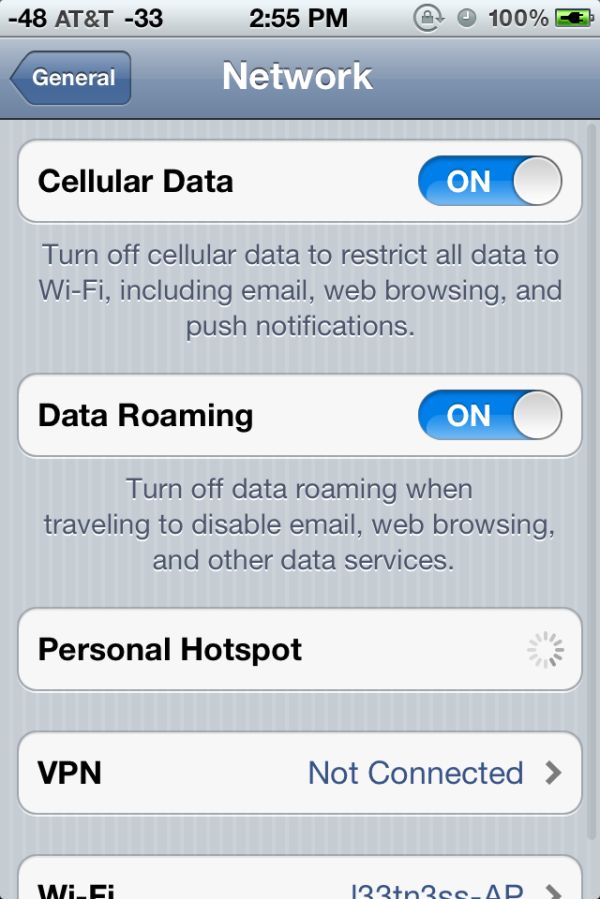
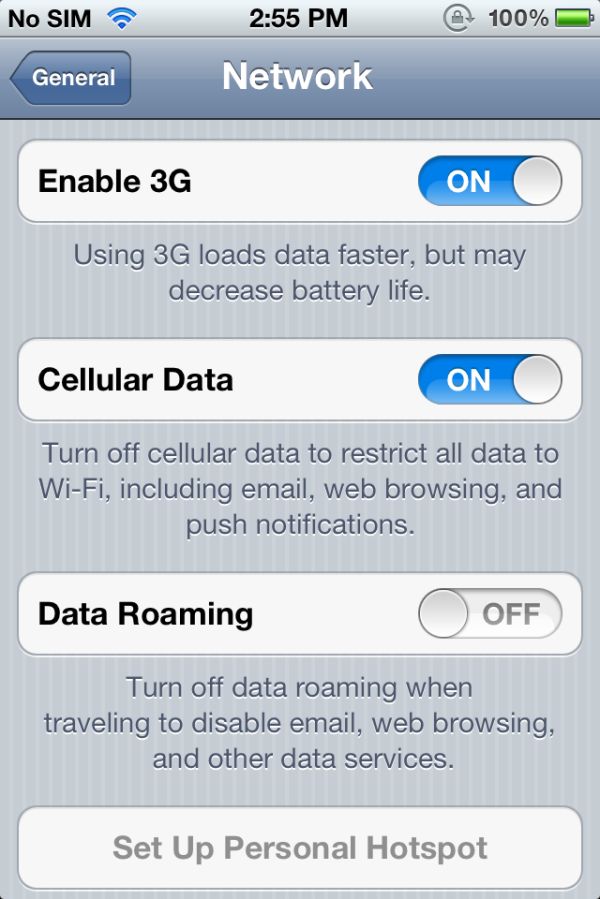
Left: iPhone 4S (no 3G toggle), Right: iPhone 4 (3G toggle)
It’s likely that this is absent to accommodate the multi-mode nature of the 4S (and thus the lowest common denominator CDMA mode), however the absence of this toggle makes getting connected in congested areas more difficult. In some markets, (I’m looking at you, AT&T in Las Vegas), EDGE is often the only way to get any connectivity, even without a major convention going on. Not having that 3G toggle makes manually selecting that less-used but more reliable connection impossible now, to say nothing of the potential battery savings that this would afford (and that we sadly can’t test now).
There’s one last tangential question about HSPA+ on the 4S, specifically on AT&T. I’ve left this to the end since it doesn’t impact non-US 4S users, but the last question is whether the 4S is actually on HSPA+. For a while, I was concerned that AT&T would continue using the wap.cingular APN on the 4S which seems shaped to around 7.2 Mbps HSDPA. I’m glad to report that AT&T hasn’t continued using wap.cingular on its 4S data plans, instead using “phone” which is a newer APN that allows for HSPA+ (above 7.2 Mbps) rates. You can check this yourself under PDP Context Info on the 4S in field test.


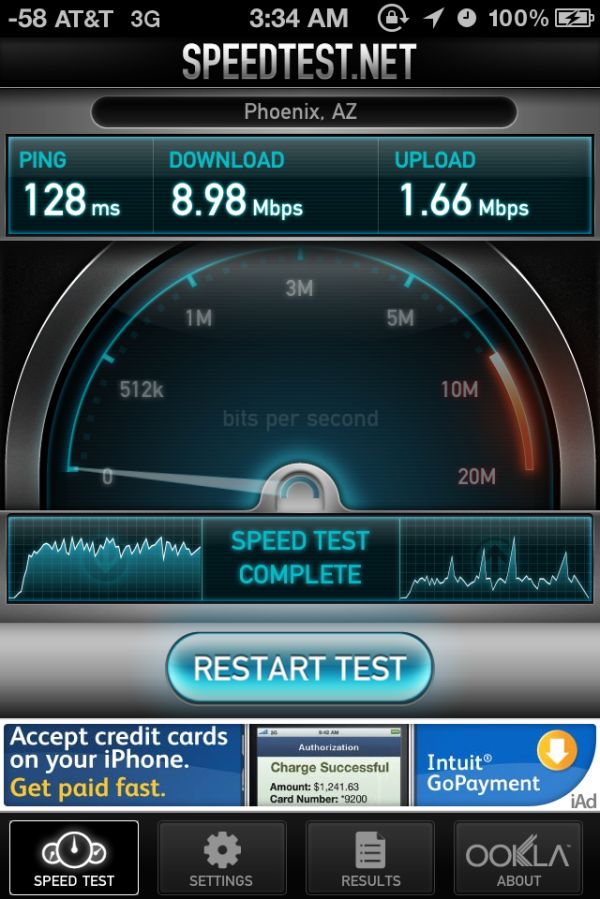
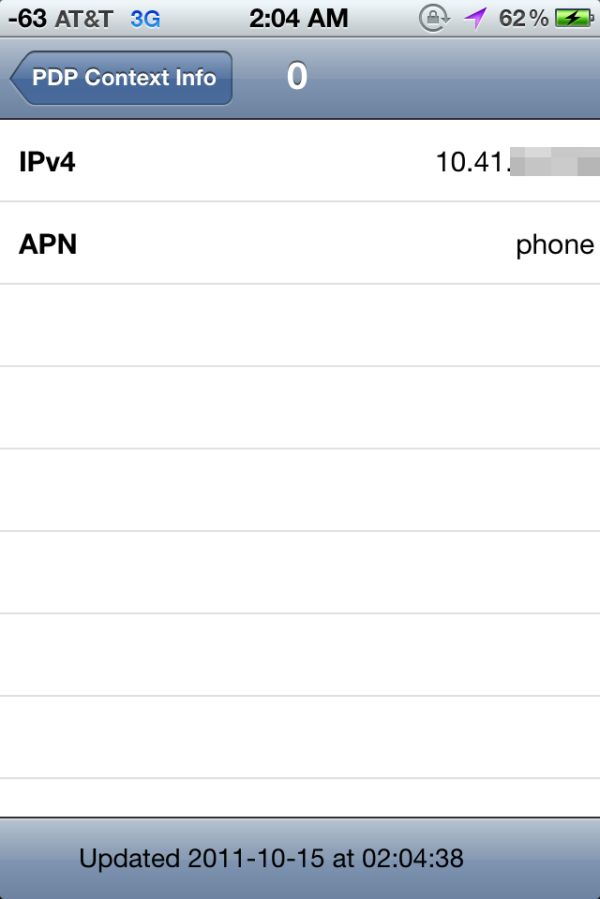








199 Comments
View All Comments
Lucian Armasu - Wednesday, November 2, 2011 - link
Anand, you said the GLbenchmark is the only good cross-platform graphics benchmark. Was GLBenchmark made originally for iOS? Don't you think that it could be biased (possibly unintentionally) towards shader performance in its scores, which would make it favor the PowerVR GPU's more?At the end of the day, these are all just syntethic benchmarks, and sometimes they could be way off from real world performance tests. So what if GLBenchmark doesn't give a too big score for stuff that the other chips are good at, like physics, geometry, whatever, and it gives higher score for shader stuff?
Another question, don't you think shader performance is starting to limit what the games can show about now? Will it really help games that much if they received 20x shader performance in the next 2 years?
thunng8 - Wednesday, November 2, 2011 - link
Glbenchmark was originally release for Linux, Symbian and Windows Mobile.thunng8 - Wednesday, November 2, 2011 - link
Also you do realize that Glbenchmark consists of many tests including some primitive tests like fill rate and Geometry?By other Gpu, do you mean the Mali-400 or GeForce ulp? The standout result I saw was how weak the Mali was at geometry being 4x slower while fill rate was less than 2x slower than the 543mp2
lemmo - Wednesday, November 2, 2011 - link
Thanks for the review, but did I miss analysis on audio quality... for music, not voice quality?You've started this with the Galaxy S2, really useful, and I believe you're developing your testing methodology. But any indication how the iPhone audio quality compares to S2, Prime and others?
cacca - Wednesday, November 2, 2011 - link
if nobody has photo-shopped the images at page 3 i not quite strenge that you have a better throughput.iPhone 4 test done at PM 4.24, a normal afternoon, with quite a lot of traffic
iPhone 4s test done at AM 3.34, a quite early bird, no problems or fight for resources with other phones
To you is normal to test at so different times? An for you there is no difference between a late afternoon and 3.34 in the morning?
bah
koinkoin - Wednesday, November 2, 2011 - link
I was wondering what the battery time is when you call with a headset. I do almost all my call with a headset to keep my hand free (on the wheel or keyboard). How much does this affect the battery time.Also I use a Blackberry and it always check for new email, I sometime read the mail while on the phone, when you do the talk time test is there a connection for email open?
koinkoin - Wednesday, November 2, 2011 - link
I was wondering what the battery time is when you call with a headset. I do almost all my call with a headset to keep my hand free (on the wheel or keyboard). How much does this affect the battery time.Also I use a Blackberry and it always check for new email, I sometime read the mail while on the phone, when you do the talk time test is there a connection for email open?
Griswold - Wednesday, November 2, 2011 - link
I dont think the results the new camera deliver are superior to the one in the iphone4. Judging by the vast number of shots Engadget compared between these two phones and a couple other premium phones, the iphone4s shows alot more noise than the older model, even in broad daylight. Its probably the increased pixel count, which cant be countered by the other improvements.Its not bad, but its also not better than the old camera. The old saying remains true: more pixels doesnt equal better pictures.
jwwpua - Wednesday, November 2, 2011 - link
In the section WIFI, GPS, AUDIO, SPEAKERPHONE, I don't see anything about the speakerphone. Is it louder? Any tests done? Clarity?Thanks, great review!
freezer - Thursday, November 3, 2011 - link
I think you should have the GPU benchmark using phone's native resolution. That would give more accurate results in real world gaming situation than running all phones using same resolution.The iPhone 4S 3.5" screen has much more pixels than Galaxy S2 4.3" screen which gives latter advantage in 3D speed. That is because the GPU has to draw every pixel in every frame. There's no way around it.
In fact running GL Benchmark 2.1 Pro High in native resolution gives very different results as Galaxy S2 comes at top:
http://glbenchmark.com/result.jsp?benchmark=glpro2...